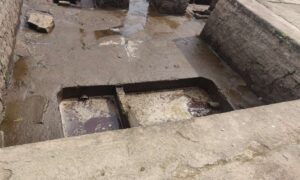Bruhat Bengaluru Mahanagara Palike (BBMP) has reintroduced the Effluent Treatment Plant (ETP), an environment friendly system at the Tannery Road Slaughterhouse.
Bengaluru, SEPT. 13: The Tannery Road Slaughterhouse now operates with a revamped Effluent Treatment Plant (ETP) system. The new system was setup 45 days ago on the premises of the slaughterhouse to help with the segregation of its waste. The implementation of the ETP in the last few days has brought a change in disposing of solid waste.
The Tannery Road Slaughterhouse now operates with a revamped Effluent Treatment Plant (ETP) system. The new system was setup 45 days ago on the premises of the slaughterhouse to help with the segregation of its waste. The implementation of the ETP in the last few days has brought a change in disposing of solid waste.
Dr Rudresh Kumar, Technical Assistant of the Joint Director of Animal Husbandry Department said, “It (ETP) wasn’t working for two to three years and recently they introduced a new plant.” He confirmed that it was opened about two months ago. The slaughterhouse falls under the jurisdiction of the Animal Husbandry department of the BBMP.
Rehmat Ullah Qureshi, a cleaning and trades contractor for Bruhat Bengaluru Mahanagara Palike (BBMP) said that the new ETP functions better than the older one. He added, the previous ETP’s waste disposal system used landfills and water bodies but the new system gives compost and pet food which he thinks is beneficial to the city and the slaughterhouse too.
An ETP is a waste processing system that is used by industries. The ETP processes the waste in a contained three-chamber system and then gives two final by-products, liquid waste and sludge. The liquid waste is further processed to give clean water which is used on site. Karthik, BBMP waste collection truck driver, said that the sludge is mixed with the wet waste collected from houses in nearby wards and then sent to a private company, who later converts it to compost for farming and pet food. The Slaughterhouse on Tannery Road comes under BBMP ward 60 and was established in 1914. The ETP has been around for 20 years yet it has not been efficient.


The slaughterhouse is involved in a tussle with the Supreme Court over the Ulsoor Lake Pollution case. The National Green Tribunal (NGT) report on the Ulsoor Lake pollution case states that in December 2021, the Central Pollution Control Board (CPCB) directed Karnataka State Pollution Control Board (KSPCB) to close the BBMP civil Slaughterhouse on Tannery road and stop all its activities with immediate effect. The Slaughterhouse still continues to work as usual and has implemented a new ETP system to better manage its effluents.
As the previous ETP system was not that effective, the BBMP divided slaughterhouses into three main categories based on size: large, medium and small for effective implementation of waste disposal. Large slaughterhouses use rendering for their disposal, medium sized slaughterhouses either render the waste or they implement controlled incineration and small slaughterhouses bury the waste. Organs of animals and sludge is disposed of by composting and is used for other commercial purposes.
Dr. Nagaraja, Professor and Chairman of the Department of Environmental Science of the Bangalore University and his Ph.D. student Kavana R talked about the ETP. Dr.Nagaraja said, “Most of the slaughterhouses in Bengaluru are directly letting waste go into the sewage system. There is no dedicated system for waste disposal. The implementation of this new ETP makes this waste disposal system effective. ETP is a good concept.”

Kavana added, “The issue with slaughterhouses in the market is that the liquid and solid waste is not properly managed and this leads to breeding of mosquitos and increase in stray dog population in addition to spread of dangerous viruses or bacterias. The residue of antibiotics used in the animals will also be there so it is good that it is now being processed and not just disposed of.” She further said, “After ETP, the last stage which is mandatory is the quality analysis to check the water quality for presence of any biologically harmful organisms.”
Kavana mentioned that it is mandatory for all ETPs to have the final product tested to confirm that there is no harmful pathogen or bacteria present. An employee from the Slaughterhouse confirmed that they do not follow this protocol as they don’t conduct the Quality Analysis test for the final product.





Very well researched! Great work!
Well covered
Good info.
Thank you for the sensible critique. Me & my neighbor were just preparing to do a little research on this. We got a grab a book from our local library but I think I learned more from this post. I am very glad to see such fantastic info being shared freely out there.